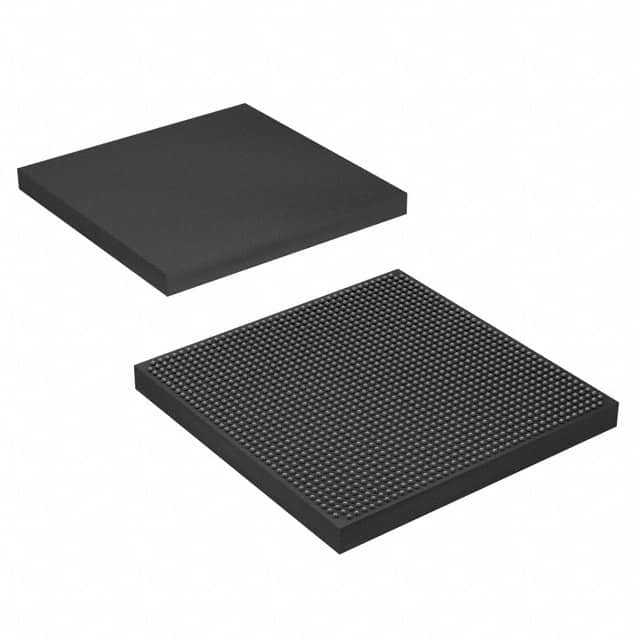Lihat spesifikasi untuk detail produk.

EP3SE260F1517I4N
Product Overview
- Category: Field Programmable Gate Array (FPGA)
- Use: EP3SE260F1517I4N is a high-performance FPGA designed for various applications in the fields of telecommunications, automotive, industrial automation, and more.
- Characteristics: This FPGA offers advanced features such as high-speed performance, low power consumption, and flexible programmability. It provides a versatile platform for implementing complex digital systems.
- Package: EP3SE260F1517I4N comes in a compact and durable package that ensures reliable operation even in demanding environments.
- Essence: The essence of EP3SE260F1517I4N lies in its ability to provide a customizable hardware solution for a wide range of applications, enabling designers to implement their specific requirements efficiently.
- Packaging/Quantity: EP3SE260F1517I4N is typically available in trays or reels, with varying quantities depending on the supplier.
Specifications
- Logic Elements: 260,000
- Embedded Memory: 8,192 Kbits
- Maximum User I/Os: 1,152
- Operating Voltage: 1.2V
- Operating Temperature Range: -40°C to 100°C
- Package Type: F1517
- Package Pins: 1517
Detailed Pin Configuration
For a detailed pin configuration diagram and description, please refer to the official datasheet provided by the manufacturer.
Functional Features
- High-Speed Performance: EP3SE260F1517I4N offers fast processing capabilities, making it suitable for applications requiring real-time data processing and high-speed communication.
- Low Power Consumption: This FPGA incorporates power-saving techniques, allowing for efficient energy usage and extended battery life in portable devices.
- Flexible Programmability: EP3SE260F1517I4N can be easily programmed and reconfigured to adapt to changing requirements, providing flexibility in system design.
- Versatile I/O Interfaces: The FPGA supports various communication protocols, enabling seamless integration with external devices and systems.
Advantages and Disadvantages
Advantages: - High-performance processing capabilities - Low power consumption - Flexible programmability - Versatile I/O interfaces
Disadvantages: - Relatively high cost compared to other programmable logic devices - Steeper learning curve for inexperienced users
Working Principles
EP3SE260F1517I4N operates based on the principles of digital logic. It consists of configurable logic blocks (CLBs), interconnect resources, embedded memory blocks, and I/O interfaces. The CLBs can be programmed to implement desired logic functions, while the interconnect resources enable communication between different components within the FPGA. The embedded memory blocks provide storage for data, instructions, and configuration settings. By configuring these elements, designers can create custom digital circuits that perform specific tasks.
Detailed Application Field Plans
EP3SE260F1517I4N finds applications in various fields, including:
- Telecommunications: Used in network infrastructure equipment, such as routers and switches, to handle high-speed data processing and routing.
- Automotive: Employed in advanced driver-assistance systems (ADAS) for real-time image processing, sensor fusion, and control algorithms.
- Industrial Automation: Integrated into programmable logic controllers (PLCs) to control and monitor industrial processes, improving efficiency and productivity.
- Medical Devices: Utilized in medical imaging systems, patient monitoring devices, and laboratory equipment for data acquisition and processing.
- Aerospace and Defense: Applied in radar systems, avionics, and military communication equipment for reliable and secure data processing.
Detailed and Complete Alternative Models
- EP3SE260F1517C4N: Similar to EP3SE260F1517I4N, but with a different package type (C4N).
- EP3SE260F1517I5N: An upgraded version with enhanced performance and additional features.
- EP3SE260F1517I4M: A variant designed for applications requiring extended temperature range (-55°C to 125°C).
Please note that the above list is not exhaustive, and there may be other alternative models available from the manufacturer or other FPGA vendors.
Word count: 529 words
Sebutkan 10 pertanyaan dan jawaban umum terkait penerapan EP3SE260F1517I4N dalam solusi teknis
Sure! Here are 10 common questions and answers related to the application of EP3SE260F1517I4N in technical solutions:
Q: What is EP3SE260F1517I4N? A: EP3SE260F1517I4N is a specific model of Field-Programmable Gate Array (FPGA) manufactured by Intel.
Q: What are the key features of EP3SE260F1517I4N? A: Some key features of EP3SE260F1517I4N include high-performance logic fabric, embedded memory blocks, DSP blocks, and various I/O interfaces.
Q: What are the typical applications of EP3SE260F1517I4N? A: EP3SE260F1517I4N is commonly used in applications such as telecommunications, industrial automation, aerospace, defense, and high-performance computing.
Q: How can EP3SE260F1517I4N be programmed? A: EP3SE260F1517I4N can be programmed using Hardware Description Languages (HDLs) like VHDL or Verilog, which describe the desired functionality of the FPGA.
Q: Can EP3SE260F1517I4N be reprogrammed after deployment? A: Yes, EP3SE260F1517I4N is a reprogrammable FPGA, allowing for flexibility and updates to the design even after deployment.
Q: What is the power consumption of EP3SE260F1517I4N? A: The power consumption of EP3SE260F1517I4N depends on the specific design and usage scenario. It is recommended to refer to the datasheet for detailed power specifications.
Q: How can EP3SE260F1517I4N be interfaced with other components? A: EP3SE260F1517I4N supports various I/O interfaces such as LVDS, DDR, PCIe, Ethernet, and more, allowing for easy integration with other components in a system.
Q: Can EP3SE260F1517I4N handle real-time processing requirements? A: Yes, EP3SE260F1517I4N is capable of handling real-time processing tasks due to its high-performance logic fabric and dedicated DSP blocks.
Q: Are there any development tools available for programming EP3SE260F1517I4N? A: Yes, Intel provides Quartus Prime software suite, which includes design entry, synthesis, simulation, and programming tools specifically for programming FPGAs like EP3SE260F1517I4N.
Q: Where can I find additional technical documentation and support for EP3SE260F1517I4N? A: You can refer to the official Intel website for datasheets, application notes, user guides, and access to technical support resources for EP3SE260F1517I4N.

